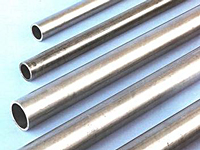| Items |

6063-T6SP40-1000-133
Seamless Aluminum Pipe - Series 6063-T6 Schedule 40
|

6063-T6SP40-1250-140
Seamless Aluminum Pipe - Series 6063-T6 Schedule 40
|

6063-T6SP40-1500-145
Seamless Aluminum Pipe - Series 6063-T6 Schedule 40
|

6063-T6SP40-2000-154
Seamless Aluminum Pipe - Series 6063-T6 Schedule 40
|

6063-T6SP40-2500-203
Seamless Aluminum Pipe - Series 6063-T6 Schedule 40
|
|
Material
|
N/A
Aluminum
|
|
Shapeform
|
N/A
Pipe
|
|
Series
|
N/A
6063-T6
|
|
Grade
|
N/A
6063
|
|
Preparation
|
N/A
Stenciled
|
|
Temper
|
N/A
T6
|
|
Standard
|
N/A
Schedule 40
|
|
Nominal Size
|
N/A
1 inches
|
N/A
1 1/4 inches
|
N/A
1 1/2 inches
|
N/A
2 inches
|
N/A
2 1/2 inches
|
|
Nominal Size
|
N/A
1 inches25.4 mm
|
N/A
1.25 inches31.75 mm
|
N/A
1.5 inches38.1 mm
|
N/A
2 inches50.8 mm
|
N/A
2.5 inches63.5 mm
|
|
O.D.
|
N/A
1.315 inches33.401 mm
|
N/A
1.66 inches42.164 mm
|
N/A
1.9 inches48.26 mm
|
N/A
2.375 inches60.325 mm
|
N/A
2.875 inches73.025 mm
|
|
I.D.
|
N/A
1.049 inches26.6446 mm
|
N/A
1.380 inches35.052 mm
|
N/A
1.610 inches40.894 mm
|
N/A
2.067 inches52.5018 mm
|
N/A
2.469 inches62.7126 mm
|
|
Wall Thickness
|
N/A
0.133 inches3.3782 mm
|
N/A
0.140 inches3.556 mm
|
N/A
0.145 inches3.683 mm
|
N/A
0.154 inches3.9116 mm
|
N/A
0.203 inches5.1562 mm
|
|
Weight
|
N/A
0.5749 lbs/ft0.8555454836 kg/m
|
N/A
0.7782 lbs/ft1.1580892248 kg/m
|
N/A
0.9306 lbs/ft1.3848854184 kg/m
|
N/A
1.2508 lbs/ft1.8613955312 kg/m
|
N/A
1.9835 lbs/ft2.951773294 kg/m
|
|
Weight per 20'
|
N/A
11.497 lbs5.2150392 kg
|
N/A
15.563 lbs7.0593768 kg
|
N/A
18.611 lbs8.4419496 kg
|
N/A
25.015 lbs11.346804 kg
|
N/A
39.670 lbs17.994312 kg
|
|
ASTM Specification
|
N/A
ASME SB-241 ASME SB241M ASTM B241 ASTM B241M Mil-P-25995 UNS A96063
|
|
Length
|
N/A
20 ft
|
|
Ultimate Strength
|
N/A
35 ksi
|
|
Yield Strength
|
N/A
31 ksi
|
|
Elongation percent in 2 inches
|
N/A
12
|
|
Hardness Brinnel Number
|
N/A
73
|
|
Ultimate Shearing Strength
|
N/A
22 ksi
|
|
Fatigue Endurance Limit1
|
N/A
10 ksi
|
|
Modulus of Elasticity2
|
N/A
10.0 x 103 ksi
|
|
Resistance to Corrosion - General3
|
N/A
A
|
|
Stress Corrosion Cracking
|
N/A
A
|
|
Workability (Cold)
|
N/A
C
|
|
Mechinability
|
N/A
C
|
|
Brazeability4
|
N/A
A
|
|
Gas Weldability5
|
N/A
A
|
|
Arc Weldability6
|
N/A
A
|
|
Resistance Spot and Seam Weldability7
|
N/A
A
|
|
Applications
|
N/A
Pipe railing, furniture, architectural extrusions
|
|
Density
|
N/A
0.097 lbs/in³
|
|
Specific Gravity
|
N/A
2.70
|


